The Limited Sleeper Cache is the easiest of the Sleeper Cache Sites. Sleeper Cache sites are significantly more difficult than normal data or relic site, and pilots will be risking their ship when trying any of them. However, once familiar with these sites, pilots should be able to run the site without taking any damage. Like all Sleeper Cache sites, the Limited Sleeper Cache require the use of both Data and Relic Analyzers. Entry is restricted to frigates, and an exploration frigate is highly recommended in order to make use of their hacking bonuses.
Locating
Limited Sleeper Caches are Cosmic Signatures that you need to scan down with scanner probes. They are more difficult to scan down than normal signatures, and require well-developed scanning skills to completely scan down.
Walkthrough
Room 1
| On warp in: |
|---|
| This area has been hidden from prying eyes for years. Now the structure responsible for cloaking the site is damaged, finally allowing for a way in. A quick survey indicates this is a storage site, possibly used to store items collected by Sleepers from all over known space. What defenses or dangers lurk inside are uncertain, but the use of both a Data Analyzer and Relic Analyzer are required. The entry gate only allows frigate-sized ships through. |
Hack the Hyperfluct Generator using your Data Analyzer. Failing the hack will start a 2 minute timer, after which if you don't succeed in hacking it the site will exlpode and despawn. If you are successful a strange rift will appear that can be used to access the site.
Room 2
| On activating the Strange Rift: |
|---|
| This is a storage site by the looks of it, possibly of Sleeper origin judging by the structures around. It is heavily damaged, as if someone - or something - was frantically and forcefully searching through the site, and quite recently at that. Dangerous gases and volatile materials are all around, so care is required in navigating this hazardous place. |
Warning: This room contains many hazards, both traps and environmental - you need to navigate carefully:
- The Plasma Containers in this room will explode if you get closer than 7.5km, releasing a Plasma Gas Cloud doing significant AoE damage.
- Moving within 13.5km of the Ruptured Pressure Station without hacking the Pressure Control Unit will result in significant ongoing AoE damage to your ship and drones.
- The 3 Plasma Chamber Debris within the site have surrounding Plasma Gas Clouds that do significant AoE damage, take care to navigate around the clouds.
- The Remote Defence Grid Unit needs to be hacked first to minimise consequences of failed hacks and to disable the damaging shield that can appear when hacking a container.
Hack the Remote Defence Grid Unit first - keeping an eye on your distance from the Plasma Containers. You have multiple attempts, but if you fail the first attempt, the following message will appear in local: "Failing to hack the Remote Defense Unit seems to have set something in motion, but you can't tell what.". That means this baby will blow up in a minute or two, maybe giving you enough time for 1-2 cans. Be careful.
| On successful hack: |
|---|
| You have succeeded in deactivating the defense grid. |
Then proceed to navigate carefully around to all of the containers hacking them as you go, excluding the container covered by the Ruptured Pressure Station gas cloud.
Finally hack the Remote Pressure Control Unit (remember to stay at least 13.5km from the Ruptured Pressure Staion) this will allow you 2 minutes to then approach and hack the final container near the Ruptured Pressure Station. If you start to run out of time you will see updates of the time left appearing in the local chat window. Do not risk getting caught by this cloud, jump out of the site immediately if you are running out of time or after looting the container.
Loot
1 & 3 run BPC's for storyline modules and polarized weapons
Sleeper components
R.Db components
R.A.M. components
Science skillbooks
Meta modules.
Value of loot is normally in the range of 20-80M, averaging around 30M.
Quick Guide
A rather easy-going site, this particular gem is the first taste of Sleeper Caches most pilots will encounter. This site poses some risks, but it not as dangerous as other Sleeper Caches. Although the Limited Cache doesn't usually pay as well as the more difficult sites, it can still be worth running.
If the initial Hyperfluct Generator container has been hacked, and the accompanying Spatial Rift has spawned, another pilot has probably already entered the site. Check zKillboard or another appropriate service for any recent losses.
General Walkthrough
- Hack the entry can. Enter the site.
- Cargo scan all the cans, and evaluate the value thereof.
- If the wreck Storage Depot has good loot inside it, hack the Remote Pressure Control Unit and then extract the loot out of that container. Alternatively, tank it.
- Disable the Remote Defense Grid unit. This only has to be done to disable the Forcefield Generator guarding one specific container. You may try a different approach, detailed below.
- Hack the remaining worthy cans.
Limited Sleeper Cache Fits
Generally, all these fits have a Mobile Depot, spare probes, three drones in the drone bay, a hull repairer (armor fits), an armor repairer and a hull repairer (shield fits), and all the kit necessary to handle the encounter in the cargohold. Refitting inside the site, occasionally more than once, is normal and expected.
| Do not downgrade or alter these fits. They have been thoroughly tested and verified multiple times to be the minimum. If, by reason of skill levels or ISK you cannot fit them, then do not attempt the site. Hacking modules may be downgraded but site difficulty will increase notably; and T2 Analyzers are strongly recommended. |
Logistics vessels (a single self-sufficient capacitor stable Tech I logistics frigate is sufficient) can provide remote repairs if available to get around the requirements of local repair modules. That said, maintain a local buffer and resistance module(s) as normal.
As the reasons have been outlined before, only fits for the Heron and the Magnate will be shown. The other ships are not shown because they are not recommended. The Astero can be fit identically to the Magnate, though the normal rig configuration (Gravity Capacitor/Anti-Explosive Pump/Auxiliary Nano Pump) is good enough because the hull has a bonus to armour resistances.
Use a Mobile Depot to swap the Relic Analyzer II in place of the cargo scanner once all undesired containers have been identified. These fits are not sufficient to wander into the Area of Effect (AoE) damage cloud near the wreck alone. Both of these fits can survive a detonation of the Remote Defense Grid Unit or a run-in with a Unstable Plasma Chamber, as long as the pilot does not remain inside the AoE cloud for too long. If you have a buddy with a Logistics Frigate, then these two fits below are appropriate to use for such a scenario for the entire site itself.
Data Analyzer II
Medium Azeotropic Restrained Shield Extender
Type-E Enduring Cargo Scanner
5MN Quad LiF Restrained Microwarpdrive
Limited Adaptive Invulnerability Field I
Micro Auxiliary Power Core I
Damage Control II
Small Anti-EM Screen Reinforcer I
Small Anti-Thermal Screen Reinforcer I
Small Gravity Capacitor Upgrade I













- The fit to use for a Limited Sleeper Cache, when hacking the Remote Defense Grid Unit.
- Swap the Relic Analyzer in when needed.
- If turning off the damage cloud near the wreck with the Remote Pressure Control Unit, swap the cargo scanner for a Relic Analyzer II.
1MN Monopropellant Enduring Afterburner
Data Analyzer II
Type-E Enduring Cargo Scanner
400mm Crystalline Carbonide Restrained Plates
Damage Control II
Energized Adaptive Nano Membrane II
Micro Auxiliary Power Core I
Small Gravity Capacitor Upgrade I
Small Anti-Explosive Pump I
Small Auxiliary Nano Pump I













- The fit to use for a Limited Sleeper Cache, when hacking the Remote Defense Grid Unit.
- Swap the Relic Analyzer in when needed.
- If turning off the damage cloud near the wreck with the Remote Pressure Control Unit, swap the cargo scanner for a Relic Analyzer II.
For those players with all Level V capacitor skills (Shield Compensation to IV required for the Heron), try these fits to skip hacking the Remote Pressure Control Unit entirely, and head directly into the storage depot inside the wreck field.
| You must be able to sustain at least (as in more than) 60 Effective Hit Points per second (EHP/sec) for a ship to survive inside this damage cloud. Capacitor stability is very much ideal: if less than 4 minutes, you should not run these fits. Additionally, make sure the Relic Analyzer is set to Auto-Repeat OFF. Allowing the module to continue to cycle needlessly while hacking can result in an empty capacitor and a wreck if not properly managed. |
Relic Analyzer II
Medium Azeotropic Restrained Shield Extender
Eutectic Compact Cap Recharger
Small Shield Booster II
Adaptive Invulnerability Field II
Damage Control II
Type-D Restrained Capacitor Flux Coil
Small Capacitor Control Circuit I
Small Anti-Thermal Screen Reinforcer I
Small Anti-EM Screen Reinforcer I













- EFT tells me this fit can handle 68 EHP/sec: for Pyfa, you must add the passive recharge rate to the shield boosted rate (21 EHP/sec passive regen plus 47 EHP/sec active for a total of 68 EHP/sec for my character).
- If you are fast, you may skip the Capacitor Control Circuit, but you have to know what you're doing so you can skirt out of the damage cloud to let the capacitor recharge when the capacitor runs out.
- By upgrading the Flux Coil and the capacitor recharger to T2 equivalents, you may have enough capacitor (with Shield Compensation IV) to run for almost 4 minutes if you skip the Capacitor Control Circuit, which is what I do.
- A cap battery isn't really practical because of fitting reasons. However, you may elect to use a Shield Boost Amplifier and a small cap battery: if you have both capacitor skills to IV and Shield Compensation 0, it could be cap stable with a T2 Flux Coil and won't need a CCC rig. Always use your fitting tool to confirm.
1MN Monopropellant Enduring Afterburner
Relic Analyzer II
Eutectic Compact Cap Recharger
Small Armor Repairer II
Damage Control II
200mm Crystalline Carbonide Restrained Plates
Energized Adaptive Nano Membrane II
Small Auxiliary Nano Pump I
Small Auxiliary Nano Pump I
Small Anti-Explosive Pump I













- The Astero is fit pretty much identical to this vessel, or the "standard" rig configuration.
- The addition of a fourth mid slot can be handy, but isn't necessary. I'd prefer the Magnate for its lower cost to begin with.
- Swap the Relic Analyzer II in for when the Data hacks are completed. The cargo scanner will have to be offlined for this fit to work (it should be swapped out for a Relic Analyzer II after the intial cargo scan of the site has been conducted anyways).
- The variant of the afterburner is specifically chosen so the user doesn't have to bring two afterburners in his cargohold. It may be advisable to bring a Tech II Micro Auxiliary Power Core.
Additional notes for the Magnate:
- Because I have Astrometric Rangefinding V (yawn that was a long train), I don't need the Small Gravity Capacitor Upgrade I to scan down a Superior Sleeper Cache with the Magnate, instead I bring two Scan Rangefinding Array Is. Otherwise, my Magnate has the same rigs as shown above. As before, you will need all capacitor skills to V (which you'll need eventually anyways) and Repair Systems V to match the minimum of 60 EHP/sec to last inside the wreck field. Overheating may be required if the armor gets a bit low.
- Use the afterburner sparingly, only to get to the container and back out a little bit faster. Leaving it on can be a death sentence: pulse it. Do not run this fit if you are not capacitor stable with the afterburner and the analyzer off. I am capacitor stable at 33%, and this fit has worked well. Feel free to swap out the afterburner for another capacitor recharger.
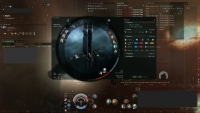
There may be some concern from the EFT warriors about the buffer module. The reason for such a module is to better buffer out the slight damage variations from damage tick to the next (much more noticeable with armor) and thus make the most of each shield or armor HP boost. For those who have a hard time with the hack inside the wreck field (sometimes I've had 7-8 failures) the buffer of the shield Heron allows it to usually stabilize around 50% shield capacity, and the natural regen of the shield starts to help a bit. For armor, it allows the pilot some more room for error if needed, particularly if overheating is necessary.
Site Introduction
Having covered the fits, let's get right to the site. Before I talk about the details of the site itself, I should divulge a bunch of images to help newcomers get familiar with the basic layout of the site, and its hazards.
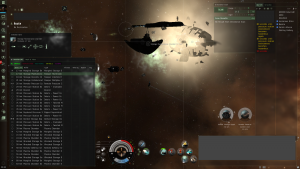 |
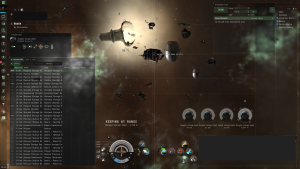 |
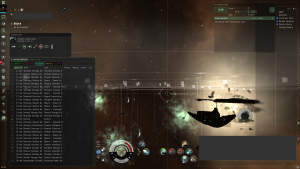 |
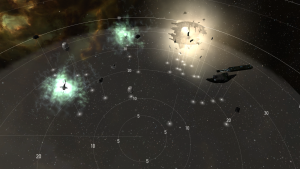 |
Use those images to get a basic idea of what the site looks like. Below there are images that highlight various hazards and objects.
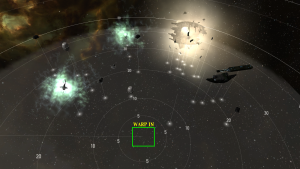 |
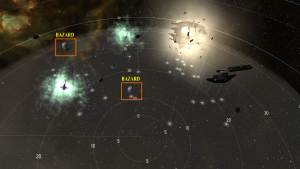 |
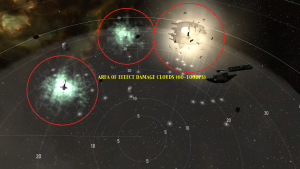 |
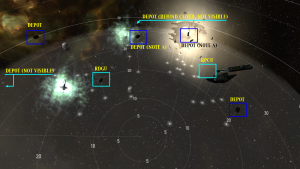 |
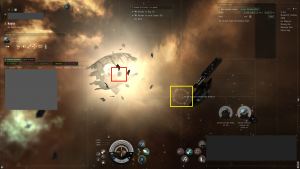 |
So specifics of the damage that is incurred upon detonation of a Plasma Chamber are hidden below, but it's not too serious unless the ship is untanked. When I first wanted to run Sleeper Caches, I found an Astero at a site that I could not scan down, so I switched to combat probes and probe out his ship. Then I wandered in and didn't know what was going on, and nearly lost the ship, warping out in 20% structure. Those were the days...
Normally the container inside the wreck and the one just to the left of it (also noted as "NOTE A" one of the pictures above) are the ones with the most value. Make sure you don't wander into the damage proximity of the wreck field when hacking that container.
Off to run the site we go!
Running the site
Once you warp to the indication, you'll land in the entry room. You should see a Hyperfluct Generator present. If it has been hacked and a rift is activated, then someone is there, or has been there. If not, it's your turn! Go ahead and hack that Hyperfluct Generator. I will list the outcomes possible below:
CAN DIFFICULTY: 7/10 [RED HACK]
SUCCESS: A new spatial rift (acceleration gate) is opened to the main area, which is called the Ransacked Storage Site.
FAILURE: You have two minutes to attempt a successful hack of the can. Should you fail within that time, the site will despawn.
By taking the Spatial Rift, the first room is made available to the player. Initially, it's important to cargo scan the containers to evaluate the value of the site. Those inexperienced with the site should probably run it anyways if there isn't much value for the experience. Drop the mobile depot to get the counter counting down. Let us assume the container inside the wreck field has good things inside it: there are two approaches of dealing with it.
| The can difficulty numbers do vary slightly each time, because of the way that the random hacking minigame is generated. For reference, high-sec rookie practice cans (in the Rookie Systems) are 1/10. Regular high sec easy-peasy cans are 3 or 4/10. Low-sec, null-sec, and wormhole space cans are 5 to 8/10, depending on the value of the can, in most cases. Generally, I've found them to be about 6 to 7/10 in difficulty. |
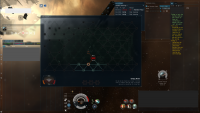
The first is to hack the Remote Pressure Control Unit, cook a Microwarpdrive (afterburner is not fast enough) to the container inside the wreck cloud, quickly hack it, then burn the Microwarpdrive back out before the timer runs out. There is enough time for 2 "standard paced" hacks, 1 "slow hack" or 3 really fast hack attempts, depends how good the hacker is and ... luck. Normally it's a red hack, which means all the usual Virus Suppressors and Restoration Nodes. The problem with this approach is both the limited timeframe and if a player cannot survive the incoming damage after the timer is up, there is a chance of explody bits.
The second approach is to fit specifically for surviving the area of affect cloud. All toxic gas clouds, both the prespawned ones and the ones that are generated upon detonation of an Unstable Plasma Chamber do similar damage per second, omni-damage types. This approach is recommended, though it does require excellent capacitor skills and proper tank skills. The advantage of this approach is the hacker can hack the container at his leisure, with little personal risk to himself before the hack can be completed.
The first method, drawn out:
- 1. Refit for the primary site fit shown up above. On a Magnate, a MWD will fit if the plate is downgraded to a 200mm variant.
- 2. Hack the Remote Pressure Control Unit (a Data hack):
- CAN DIFFICULTY: 7/10 [RED HACK]
- SUCCESS: The area of effect damage cloud surrounding the wreck is turned off for two to three minutes.
- FAILURE: No specific site penalty, a small amount of damage is absorbed by your ship -- in the test case, 96 damage against a Heron with a MSE, Limited Adaptive Invulnerability Field and Anti-EM/Anti-Thermal rigs. It's not severe enough to warrant any particular concern.
- CAN DIFFICULTY: 7/10 [RED HACK]
- 3. Immediately apply Keep at Range (2250m) on the Storage Depot inside the wreck cloud, then turn on the Microwarpdrive. Turn it off when you get close enough to it. Lock it up if not done so already, and immediately begin hacking it with the Relic Analyzer II.
- 4. Watch messages in local: if not successful by the 30 second mark, just align back to the Remote Pressure Control Unit (or straight up/straight down) and burn the Microwarpdrive. Otherwise, loot it and burn out with the Microwarpdrive to a safe direction away, probably best towards the Mobile Depot, which should be near the site warpin beacon.
The Area of Effect damage cloud near the wreck does roughly 100 DPS to a standard unmodified resistance profile of a Tech I vessel. Its approximate dimensions, measured from the Storage Depot within, is about 12km in radius.
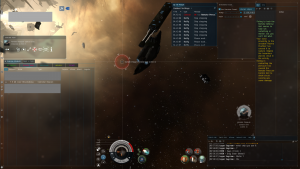 |
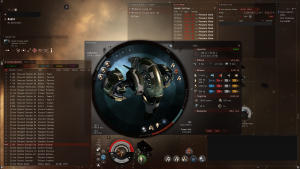 |
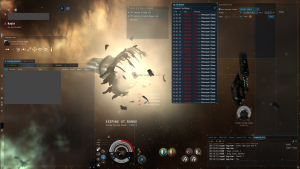 |
Now onto the second approach. The specific fit must be able to rep more than 60 EHP/sec and capacitor stability is a must. The Relic Analyzer II does not count in the capacitor stability checks: keep it off in EFT/Pyfa whilst checking for capacitor stability.
- Refit to the appropriate capstable local repair module fit.
- Approach the Storage Depot inside the wreck field. For shield tank, activate it when you are 15km from the container: for armor, activate it as soon as all the shields are gone.
- Hack the Storage Depot, loot it and go back to the Mobile Depot.
Refit back to the main site running fit. Looking at the site, look for an easy route to access the Remote Defense Grid Unit. On the way, there are area of effect damage clouds (similar DPS as the wreck field) and Unstable Plasma Chambers. The slower the vessel goes, the closer it has to be to trip the Plasma Chambers, causing them to detonate. Flying all over the place recklessly with a Microwarpdrive on is asking for trouble. While the activation distance does vary a bit, it is about 7-10km, depending on how fast you're going. While blitzing around the top or underside of the site is fine, well away from the hazards, moving slowly (200 m/sec is fine) inside, navigating the damage clouds is highly advised. Use the tactical overlay and move slowly if it's your first time.
It is possible to power through the damage clouds if they get tripped accidentally. With a Microwarpdrive active, one will only eat about 700 HP after resists...assuming the ship is immediately powered out of the wreckage field. More facts about the plasma chambers:
- Moving slowly, such as 100m/sec, allows one to get fairly close to them, nearly touching them.
- Higher speeds, such as 330m/s, the chambers can rupture from a distance of about 7km.
- Slow-boating out with a propulsion module, assuming decent 60%-ish resistances, means the player will eat about 1200 HP total.
- The area of effect damage measured from the approximate middle of the debris is 9km.
- Flying right through the cloud with a MWD on means the player will only sustain about 350 HP damage (after resists).
These figures are generalistic to give you an idea of their damage potential. A fit that can repair indefinitely, such as the ones shown earlier, will do just fine sitting inside the AoE clouds.
Now let's go back to the remainder of the site. To the far left of the site, there is one Storage Depot with an Active Forcefield Generator next to it. When a player approaches to within 10km of the Storage Depot, the Generator kicks in and fires up a EM Forcefield, which has a radius of about 14km. The other Storage Depots around the site do not have this feature and can be hacked with the Relic Analyzer II at any time without any specific concerns. For this reason, if there is just junk in the aforementioned Storage Depot, then don't bother hacking the Remote Defense Grid Unit, instead just hack the other worthy containers.
There are two approaches of going about dealing with the Forcefield...to prevent the Forcefield from being activated (activates when a ship gets to about 10km of the Storage Depot), or to turn it off after it has spawned, navigate the vessel around the AoE damage clouds and plasma chambers, then hack the the Remote Defense Grid Unit (RDGU):
CAN DIFFICULTY: 8/10 [RED HACK]
SUCCESS: The defensive forcefield generator is disabled near the far left of the site.
FAILURE: This is a very interesting topic. There appear to be two possibilities:
- Nothing happens. I once waited for one hour inside the site for "something to happen", and nothing happened. If this occurrence happens, then it seems that the can be hacked repeatedly, but be prepared for (b).
- The container explodes. A Heron with an Anti-EM Screen Reinforcer, Anti-Thermal Screen Reinforcer, Medium Azeotropic Restrained Shield Extender, a Limited Adaptive Invulnerability Field and a Damage Control II ate 1225 damage (dropped shields to about 25%), while Keeping at Range (5000m) from the container. After this, the other containers did not have any forcefield generators spawn to inhibit hacking attempts, which was distinctly unexpected. The container seems to explode about ten seconds after the hack attempt is failed.
As for the second approach, given that the the Forcefield Generator itself spawns a Large EM Forcefield, it does call for some DPS. It's not exactly difficult to destroy it, however the 150hp/sec regeneration is a problem. 110 DPS is not enough: and given that Destroyers and Stealth Bombers cannot enter the site, this is a job for either multiple people or a high-damage frigate, such as an Assault Frigate or something like a Taranis. A test with an all-damage fit Taranis which did 304 DPS unheated using Void S (36 rounds exactly, with two Hobgoblin IIs) took it out handily in 20 seconds.
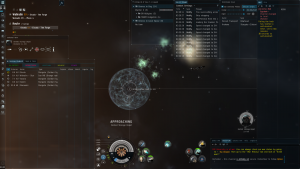 |
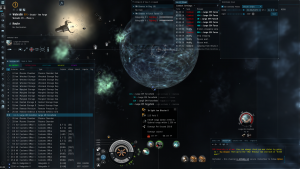 |
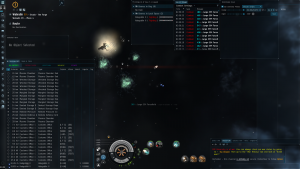 |
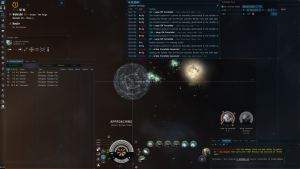 |
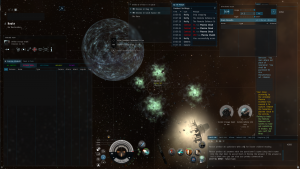 |
Shoot the Large EM Forcefield, not the Generator. The Generator cannot be damaged. The Generator will not spawn another Forcefield after the first is destroyed, so the container is open to grabs. Because an Astero does about 115 DPS with all level V skills, it's not going to be enough to overcome the self-regeneration shield value of the Forcefield.
Moving on. Hack the rest of the Storage Depots as desired. Move around the damage clouds, and take things slowly for those unfamiliar with the site:
CAN DIFFICULTY: 7/10 - 8/10 [YELLOW TO RED HACKS]
SUCCESS: The loot inside the Storage Depot can be acquired.
FAILURE: No penalty.
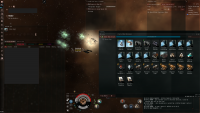
With all the good containers scooped up, run over to the Mobile Depot, refit to the travel fit, pick up the Mobile Depot, and warp off to continue on the Grand Journey that is exploration. A rather tidy video which should help with some visual understanding of the site can be found here.
Like cheap ships? The Incursus is what I normally use if someone messes up a site: it can tank the damage clouds fine, swaps easily for a 240DPS blaster fit for shooting the EM Forcefield, and does just fine. Hacks are more difficult but not impossible -- in fact, the image to the right where I challenged myself to do the site in an Incursus was the best Limited Sleeper Cache I've ever done.
